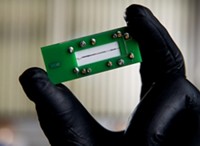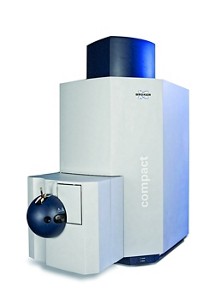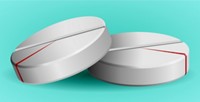Advertisement
Grab your lab coat. Let's get started
Welcome!
Welcome!
Create an account below to get 6 C&EN articles per month, receive newsletters and more - all free.
It seems this is your first time logging in online. Please enter the following information to continue.
As an ACS member you automatically get access to this site. All we need is few more details to create your reading experience.
Not you? Sign in with a different account.
Not you? Sign in with a different account.
ERROR 1
ERROR 1
ERROR 2
ERROR 2
ERROR 2
ERROR 2
ERROR 2
Password and Confirm password must match.
If you have an ACS member number, please enter it here so we can link this account to your membership. (optional)
ERROR 2
ACS values your privacy. By submitting your information, you are gaining access to C&EN and subscribing to our weekly newsletter. We use the information you provide to make your reading experience better, and we will never sell your data to third party members.
Analytical Chemistry
Taking a Close Look at LDL Cholesterol
by A. MAUREEN ROUHI, C&EN WASHINGTON
November 22, 2004
| A version of this story appeared in
Volume 82, Issue 47
It is dogma that high levels of low-density lipoprotein (LDL) cholesterol--the bad cholesterol--significantly increase the risk of heart disease. So we regularly check our LDL levels. But in trying to assess risk for heart disease, the bad-cholesterol number may not be the right one to monitor.
COVER STORY
TAKING A CLOSE LOOK AT LDL CHOLESTEROL
"Because people figured out how to measure cholesterol in the blood a long time ago, people have been measuring cholesterol and imagining that it was giving them a good representation of LDL levels in patients," says James D. Otvos, founder and chief scientific officer of LipoScience, Raleigh, N.C. Many studies show, however, that LDL cholesterol is not as good a predictor of heart disease as it is touted; what is more reliable is the number of LDL particles, Otvos says. The bad-cholesterol numbers we routinely get during our annual physical examinations could be misleading when assessing risk, he suggests.
Lipoproteins are the vehicles for transporting cholesterol and trigylcerides in the blood stream. They have a common structure: a neutral lipid core surrounded by a spherical shell of phospholipids and protein. Lipoprotein particles vary in density and are categorized as very low density, low density, and high density. The particles also vary in size.
"If every LDL particle had the same size and had exactly the same amount of cholesterol, then LDL cholesterol would be a perfect, completely faithful marker of the number of LDL particles," Otvos says. But suppose two people with the same level of LDL cholesterol have LDL particles of vastly different sizes. The individual with smaller particles would have to have more particles to carry the equivalent amount of cholesterol. All other factors being equal, that person is at higher risk for heart disease.
Otvos is on a mission to convince the medical community to adopt LDL particle number in place of LDL cholesterol. A major hurdle is the perceived difficulty of measuring LDL particle number. At present, LDL particle number is accessible only through an immunoassay of apolipoprotein B. According to Otvos, one molecule of this protein is present on every LDL particle, as well as on every very low density lipoprotein (VLDL) particle. Because LDL particles greatly outnumber VLDL particles, the level of apoliprotein B gives a reasonable approximation of the number of LDL particles. "However," Otvos says, "as with all protein immunoassays, measurement reproducibility is limited and standardization is required to ensure good interlaboratory accuracy."
Otvos trumps these analytical challenges with LipoScience's methodology based on nuclear magnetic resonance spectrometry. In Raleigh, LipoScience has 16 400-MHz NMR spectrometers analyzing clinical samples. After much jury-rigging, the instruments are fully automated. With the push of a button, they analyze the number of LDL--and VLDL and high-density lipoprotein--particles in blood plasma samples with no additional sample preparation or reagents.
"We plan to make further engineering modifications to the machinery so that we can make available to labs worldwide an NMR analyzer that will initially do this one important test with proven clinical value," Otvos says. "The menu of test offerings will then expand over time." LipoScience is considering potential collaborations with major NMR instrument suppliers.

Deconvolution is based on knowing the spectral characteristics of a library of reference standards that represent all lipoprotein particles likely to be found in human plasma, Ostvos explains. That information doesn't come easily. "It's a tremendous effort to physically isolate reference samples of each of the different-size particles. We have spent years doing that," he says, "and we have figured out computationally how to use the information. It would be extremely difficult to extract meaningful information from the NMR spectrum otherwise."
Cholesterol testing is a billion-dollar market, Otvos says. He has no illusions that the use of LDL cholesterol to assess the risk for heart disease will change overnight. Resistance to adopting an alternative LDL measure is strong because so much effort has been invested into educating the public about the importance of cholesterol, he explains.
With disease prediction by LDL particle number demonstrably better than that by LDL cholesterol, Otvos says, he is convinced that change will happen eventually. "The methodology behaves beautifully. We can crank out very good, very reproducible, very accurate information very efficiently," he tells C&EN. "We think this will drive the introduction of NMR spectrometry into clinical laboratory medicine."






Join the conversation
Contact the reporter
Submit a Letter to the Editor for publication
Engage with us on Twitter